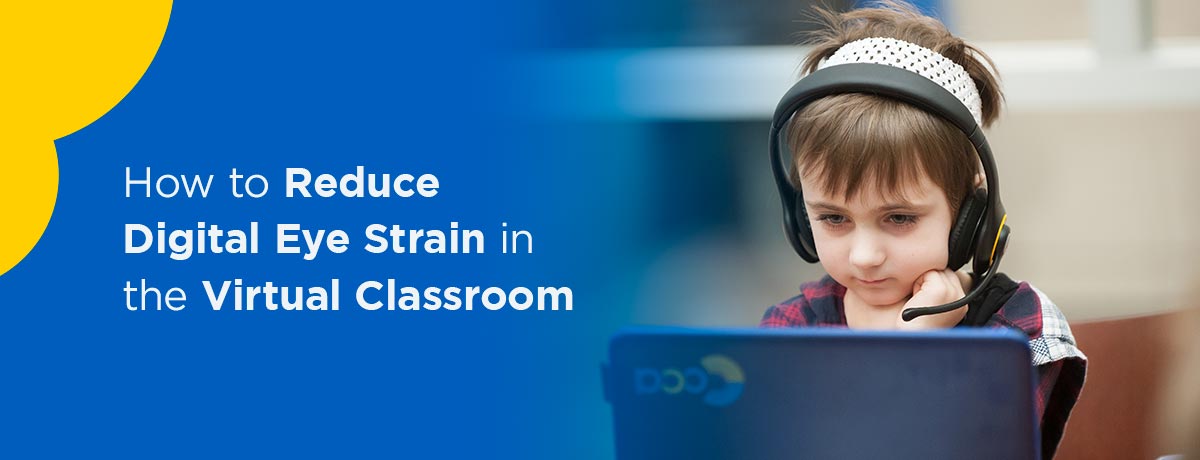2025-2026 School Year Enrollment Now Open. Click Here
2025-2026 School Year Enrollment Now Open. Click Here

The average American spends hours a day using the computer, whether it’s working in an office or taking classes at home. With this prolonged screen exposure comes the increased risk of digital eye strain. That’s why taking regular breaks from the computer and making proper adjustments for a comfortable workspace are crucial.
Anyone who regularly works on a computer should take the necessary precautions to protect their eyes, and cyber school students are no exception. Learn about the causes of eye strain, some common symptoms, and how to reduce eye strain during online classes.
Digital eye strain — also called computer vision syndrome (CVS) — is a group of eye-related problems that result from frequent screen usage. Electronic devices like computers, cell phones, televisions, and tablets can cause digital eye strain. Compared to reading a printed page, looking at a digital screen requires the eyes to work harder. Generally, letters and words on a screen aren’t as sharply defined or precise.
Additionally, the contrast level of the letters to the background is reduced. Reflections and glare on the screen can make reading and viewing difficult. As a result, the high visual demands and intricate screen characteristics can increase the viewer’s susceptibility to vision-related symptoms.
Here are some additional factors that may cause CVS:
CVS can affect online learners in various ways. It’s important to recognize and identify the signs so you can work toward correcting them sooner. Here are some of the most common symptoms associated with digital eye strain:
It’s vital that online students take sufficient breaks, have the right equipment, and make the necessary workspace adjustments to avoid eye strain. If you’re looking for ways to reduce eye strain from computers and other devices, consider these four helpful tips for your child.
To prevent and alleviate CVS, your child should take regular breaks from the computer. Here are some suggestions for building consistent screen breaks into your student’s school day:
Your child should use their break time to stretch their arms and legs, walk around, grab a snack or beverage, or go outside for a few minutes. Practicing some deep breathing exercises is another good way to recharge before returning to the computer. Set a regular timer for your child so they know when it’s time to get up and walk away from the screen.
Blue light from electronic devices can make it difficult to concentrate on the screen, making the eyes work extra hard to focus. That’s why blue light glasses have special filters in their lenses that help absorb or block blue light — and UV light, in some cases — from getting through.
These glasses are designed to increase contrast on the screen, helping to enhance focus and reduce the risk of eye strain. Consider investing in a pair of blue light glasses for your child to use while doing their school work.
If you’re wondering how to make the computer screen eye-friendly, some slight adjustments to the work environment can make a considerable difference. Try out the following methods:
You’ll want to adjust your child’s class schedule with their health needs. Whether your child wishes to take breaks hourly or follow the Pomodoro Technique, their schedule should accommodate these needs to reduce eye strain as much as possible. Luckily, CCA’s flexible online learning environment enables students to access education at a time and manner that works best for their families and personal schedules.
If your student is experiencing frequent symptoms of eye strain while studying, reading, or taking classes, we strongly recommend trying the above tips and techniques. If their CVS symptoms become more severe, consider talking to an eye doctor.
At CCA, we understand the importance of eye safety and strain prevention for students. That’s why our personalized education program and scheduling options encourage regular breaks for students, which can reduce the likelihood of eye strain occurring. Our teachers collaborate with families and students to accommodate their schedules while tailoring the curriculum to their skills, interests, and needs.
While traditional schools often use the same cookie-cutter educational approach, we understand this isn’t the best fit for every student. That’s why we leverage technology for a customized learning experience that engages each child’s unique abilities, works well with their schedule, and prepares them for the future after graduation.
For more information regarding the benefits of CCA’s flexible scheduling and online learning environment, contact us today.
2025-2026 School Year Enrollment Now Open. Click Here